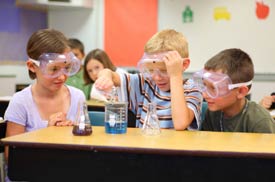 In recent years, our nation has been spending a great deal of time, energy and dollars to ensure that our students receive a solid educational foundation in reading, writing and mathematics. Today, much of the nation is also increasing its focus on the sciences.
In recent years, our nation has been spending a great deal of time, energy and dollars to ensure that our students receive a solid educational foundation in reading, writing and mathematics. Today, much of the nation is also increasing its focus on the sciences.
In a recent article, "Science is gaining momentum in American schools," EducationNews.org noted: "It has taken prodding by industry, business, and government leaders — alarms going off, even — but science education is getting an upgrade in many classrooms..." Why the heightened awareness? Given the changes in the global economy, parents, educators and policy makers alike are demanding that we provide students with more opportunities to develop the knowledge and skills that will serve to springboard them into fields like energy technology, health care and engineering.
So how can we cultivate our students’ passion for science and discovery? It comes down to the two parts of a single idea: "WE can spend more TIME."
Regarding TIME: If we simply spent more TIME teaching science, as it turns out, more students would be likely to end up pursuing science-related careers. At Springside School in Philadelphia, they have put a great emphasis on science, and in recent years, about half of their graduates have expressed an interest in pursuing such paths.
But what if WE put more of OURSELVES into our classrooms? I propose that in bringing in the PEOPLE element, we can bring back the fun and the wonder. With our students, we can hatch more butterflies, build more baking soda and vinegar volcanoes, spend more nights stargazing, and maybe even make more electric pickles. Such experiences offer great ways to spur both discussion and show students that it’s wonderful and HUMAN to have a passion for scientific discovery.
Overall, I think we can simply do a better job of showing students that science is about people, and that it’s the people who make it exciting. We can bring in parents with science-related careers as guests to help with experiments and discussions. We also have a lot to learn from great "science celebs" like Bill Nye the "Science Guy"and Steve Spangler; they offer all sorts of resources and ideas that we can use to light that fire for discovery in our students.
Jun 17, 2010
Categories: Reading & Learning
Tags: academic success, learning through play, motivating students, novelty, play, science, teacher impact

